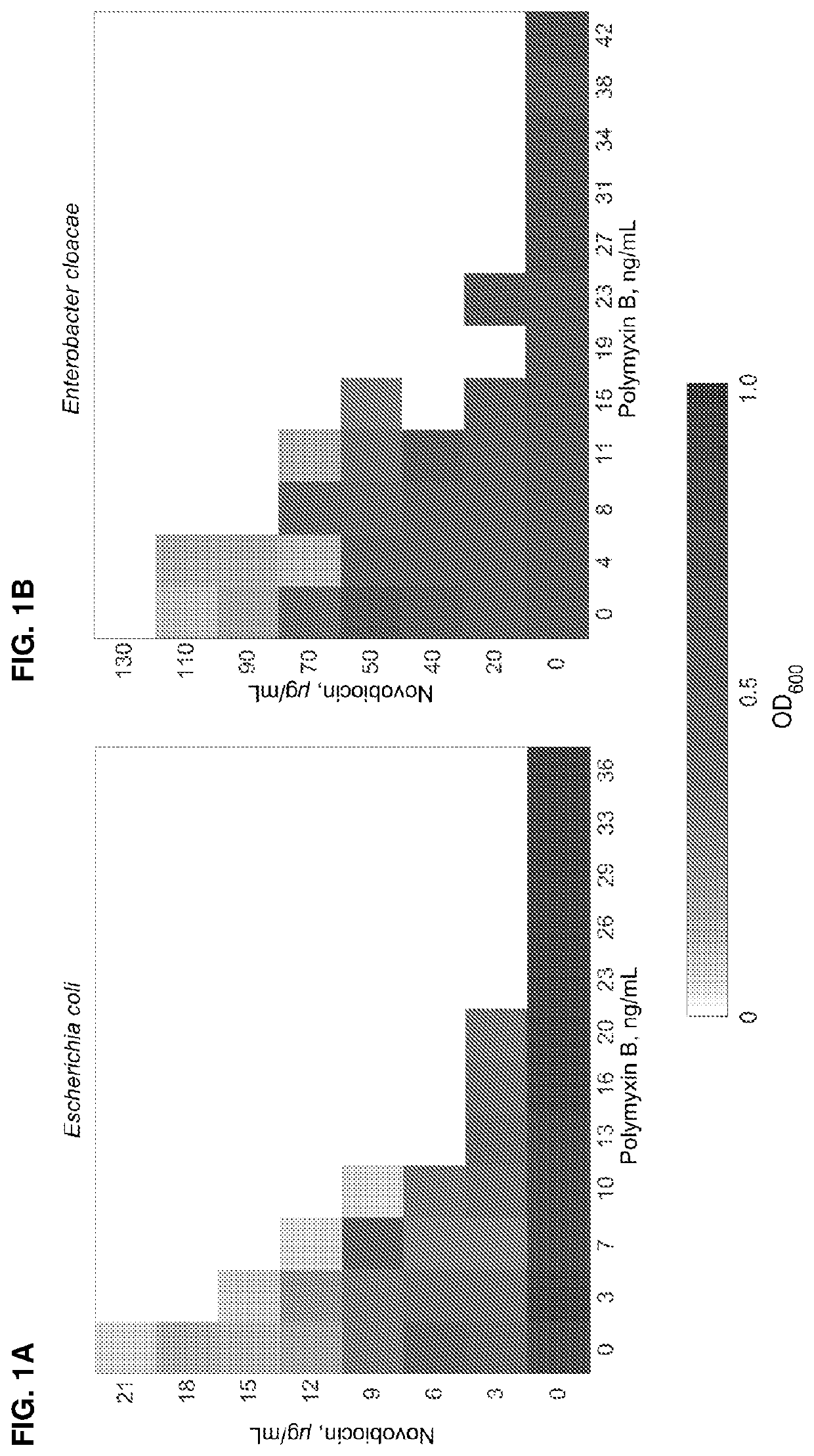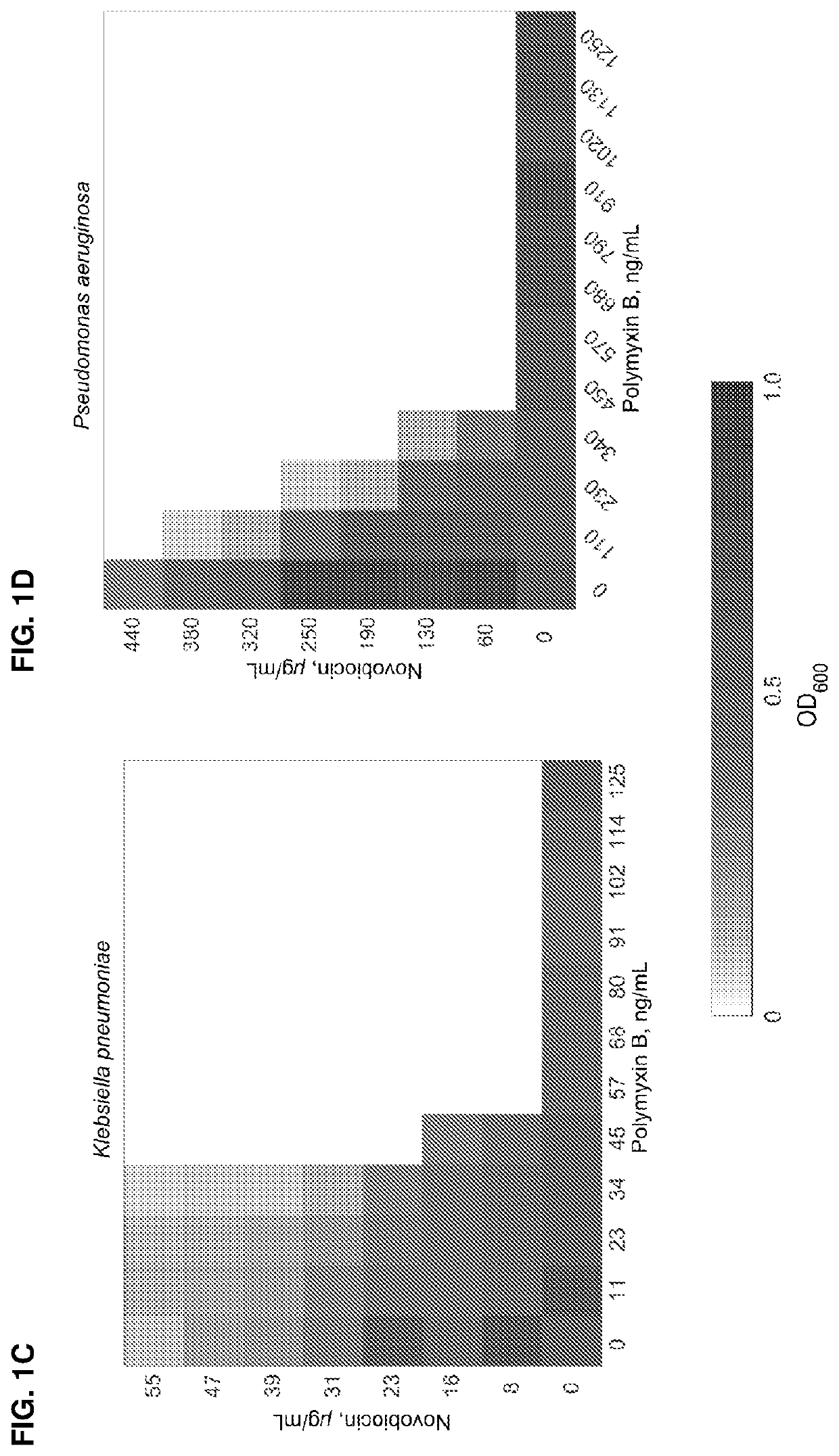Methods of treatment for bacterial infections
- Summary
- Abstract
- Description
- Claims
- Application Information
AI Technical Summary
Benefits of technology
Problems solved by technology
Method used
Image
Examples
example 1
f Novobiocin Compounds and Polymyxin Compounds
[0105]Checkerboard microdilution assays between polymyxin B and novobiocin were performed in wild-type strains (unless otherwise noted) grown at 37° C. for 24 h. Checkerboard data (FIG. 1A-1F) are representative of at least three biological replicates. The following strains were tested: A) Wild-type Escherichia coli, ATCC 25922; B) Wild-type Enterobacter cloacae; ATCC 13047) Wild-type Klebsiella pneumoniae, ATCC 700721; D) Wild-type Pseudomonas aeruginosa, ATCC 15692 (PAO1); E) Wild-type Acinetobacter baumannii, ATCC 19606; F) novobiocin-resistant Acinetobacter baumannii, ATCC 19606 gyrB (R150C). The data indicate that novobiocin synergizes with polymyxin B to kill Gram-negative pathogens in vitro. Table 1 below shows the minimal inhibitory concentrations (MIC) of polymyxin B and novobiocin.
TABLE 1MIC inhibitory concentrations of polymyxin B and novobiocin.Polymyxin BNovobiocin(ng / mL)(μg / mL)Klebsiella pneumoniae1000270Acinetobacter bauma...
example 2
ic Mouse Thigh Infection Efficacy
Animals
[0109]Female CD-1 mice from Charles River Laboratories were allowed to acclimate for 5 days prior to start of study. Animals were housed four per cage with free access to food and water. Mice received two doses of cyclophosphamide on days −4 and −1 with 150 mg / kg and 100 mg / kg delivered IP, respectively. All procedures were performed to NeoSome IACUC policies and guidelines as well as OLAW standards.
Inoculum Preparation
[0110]E. coli strain ATCC 25922 was prepared for infection from an overnight plate culture. A portion of the plate was resuspended in sterile saline and adjusted to an OD of 0.15 at 625 nm. The adjusted bacterial suspension was further diluted to target an infecting inoculum of 1.5×105 CFU / mouse, the actual inoculum size for E. coli was 1.45×105 CFU / mouse. Plate counts of the inoculum was performed to confirm inoculum concentration.
Infection
[0111]Mice were inoculated with 100 μL of the prepared bacterial suspension via intramusc...
example 3
dal synergy between novobiocin aglycone and polymyxin B
[0115]An in vitro gyrase supercoiling assay was performed with novobiocin aglycone and novobiocin (FIG. 5A) that shows that novobiocin aglycone does not inhibit E. coli gyrase activity. The combination of novobiocin aglycone and polymyxin B is bactericidal, as shown in FIG. 5B. These results suggest a killing mechanism that does not involve gyrase inhibition.
PUM
| Property | Measurement | Unit |
|---|---|---|
| Time | aaaaa | aaaaa |
| Time | aaaaa | aaaaa |
| Frequency | aaaaa | aaaaa |
Abstract
Description
Claims
Application Information
 Login to View More
Login to View More - R&D
- Intellectual Property
- Life Sciences
- Materials
- Tech Scout
- Unparalleled Data Quality
- Higher Quality Content
- 60% Fewer Hallucinations
Browse by: Latest US Patents, China's latest patents, Technical Efficacy Thesaurus, Application Domain, Technology Topic, Popular Technical Reports.
© 2025 PatSnap. All rights reserved.Legal|Privacy policy|Modern Slavery Act Transparency Statement|Sitemap|About US| Contact US: help@patsnap.com



